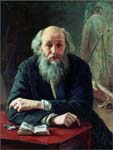Nikolai Ge

Nikolay Ge was born in 1831 in Voronezh. His ancestors were French noblemen that escaped from revolution to Russia at the end of the 18th century. Nikolay spent his early childhood in the countryside. He got upper secondary education in Kiev, where he then entered the physical and mathematical faculty of a university. However, exact sciences soon disappointed him, and he moved to St. Petersburg to enter the Academy of Arts. In 1857 his painting Witch of Endor based on a biblical story gained him a big gold medal and a creative assignment trip to Italy.
Nikolay Ge remained on the coast of the Mediterranean Sea for many years. There he traveled, studied art and went on painting. Among his works of that period one should mention Death of Virginia, Love of Vestal and The destruction of the Temple in Jerusalem. However, his work failed to give satisfaction to the artist himself. He was haunted by the feeling of aimlessness and powerlessness of his own art. Ge remembered: “I wanted to go to Russia and tell that I brought nothing because I was convinced of my absence of artistic talent”.
However, this mood disappeared after his visit to the Sistine Chapel in Rome, where he got acquainted with Michelangelo's frescos. The Last Judgment by the great Italian artist left an imperishable impression. It was this work that aroused in Nikolay Ge the interest in the New Testament, which did not leave the artist till the end of his life. Biblical themes became the basis of his creativity and brought the artist both deserved glory and ardent criticism.
In 1861 Ge started work on the painting The Last Supper, which was displayed in the Academy of Arts in St. Petersburg in 1863. The picture stirred triumph in the Russian capital. Emperor Alexander II himself purchased the canvass, the fact fueling Ge’s fame. At the same time, he faced some icy responses from the advocates of extreme Orthodoxy.
A year later Ge returned to Florence, where he painted a set of sketches and portraits. Among them there was a portrait of Herzen, with whom the artist got acquainted abroad. But evangelical plots remain the central subject of his creativity. The artist sent his two large canvasses Messengers of Revival and Christ in Gethsemane to St. Petersburg. Both the paintings were banned by church censorship and met with indifference of public. As for his Messengers of Resurrection, critics compared the figure of Maria Magdalena in the painting to a bat.
In 1875 Nikolai Ge forever left Petersburg and moved to Ukraine, where he bought a small farm. It was a period of an upheaval in his soul: for a while he declined art and concentrated on the issues of religion and morals. In his notes he mentioned that one had to make one’s living with rural work; art cannot serve as a means of living, one cannot trade art.
In 1882 the artist got acquainted with Leo Tolstoy in Moscow and later painted his portrait, sculptured his bust and illustrated Tolstoy’s story What People Live by.
Nikolai Ge died on his farm on June 13, 1894.
The main merit of Ge was that he was the first on to capture the new realistic approach to biblical compositions.
Collections of Ge’s works are kept in lots of museums of the world, including the Tretyakov Gallery (Moscow), the Russian Museum (St. Petersburg), and the Museum of Russian Art (Kiev).
